Fur broker/merchant
Michael Tager, Managing Director
Brookstone House
6 Elthorne Road
London N19 4AG
T: 020 7281 0121
E: michael@tager.co.uk
Fur broker/merchant
Michael Tager, Managing Director
Brookstone House
6 Elthorne Road
London N19 4AG
T: 020 7281 0121
E: michael@tager.co.uk
Fur broker/merchant
Steven Hurwitz, Managing Director
Units 6 & 7 The Edge Business Centre
Humber Road
London NW2 6EW
T: 0207 281 3222
E: info@hurwitz.co.uk
Fur broker/merchant
Frank Zilberkweit, Managing Director
Units 6 & 7 The Edge Business Centre
Humber Road
London NW2 6EW
T: 0207 281 2266
E: frank@london.polargrp.com
Where can I buy a fur coat?
There are many fur shops, boutiques and retail outlets where you can buy fur garments and accessories in the UK.
To find your nearest British Fur Trade Association (BFTA) member stockists please see here: http://local.britishfur.co.uk/fur-services/list-of-members/
Where can I sell my fur coat?
As a trade association we do not sell fur directly but some of our members may be able to sell your fur for you or offer part exchange.
Please contact BFTA members here: http://local.britishfur.co.uk/fur-services/list-of-members/
How much is my fur coat worth?
Generally Mink fur items hold the most value but this would depend on the condition the fur. Value depends on the type of fur and how well it has been looked after. Contact a BFTA member here: http://local.britishfur.co.uk/fur-services/list-of-members/
Can I get my fur coat remodelled?
Many of our furrier members are able to remodel fur garments. Please find your nearest furrier here:http://local.britishfur.co.uk/fur-services/list-of-members/
How should I look after my fur coat?
For details of how to store and clean your furs please see here:http://local.britishfur.co.uk/fur-services/fur-care/
Please contact your nearest BFTA Member and ask about their storage and cleaning facilities: http://local.britishfur.co.uk/fur-services/list-of-members/
Where can I get my fur coat cleaned?
Please contact your nearest BFTA Member and ask about their storage and cleaning facilities: http://local.britishfur.co.uk/fur-services/list-of-members/
For fur types please see here: http://local.britishfur.co.uk/the-fur-trade/types-of-furs/
For Latin names please see here: http://local.britishfur.co.uk/wp-content/uploads/2015/09/Latin-Names-List.pdf?f193d5
For information about endangered species please contact (the Convention on International Trade in Endangered Species of Wild Fauna and Flora): https://www.cites.org/eng
By furfashion
On the 9th of April, the BFTA (British Fur Trade Association) hosted their competition one-day workshop for fashion design students from universities all over the UK. The BFTA Annual Design Competition is one of the key parts of their University Outreach Programme, and the aim of their competition is to encourage students to be innovative in design, and to explore the exciting and creative possibilities that fur gives to design, as well as learn about fur and how it’s produced. Participants are asked to create a collection of garments that include the use of fur and is open to all UK based fashion students and recent graduates. As part of the competition process, 10 finalists are selected and invited to attend a one-day workshop, where students receive a detailed introduction to the fur industry including information on sustainability, one-to-one expert feedback on their designs and bespoke training. The day also includes a presentation showing fur techniques, a tour of a fur warehouse and information on auctions and pricing. Following the workshop, finalists are asked to further develop their designs based on the knowledge they reaped at the workshop, and winners are selected on their resubmitted entry. Prizes include an amazing expenses-paid trip to ‘Studio NAFA’ in Toronto for a week long skills developing workshop, and a place at Rebecca Bradley’s Fur Summer School in London. These pieces will then be entered into the International Fur Trade’s REMIX competition. One of the very passionate students there, Ineta, summed up the experience by expressing that she “felt like I belonged there, and I learnt so much about the fur industry, sustainability and manufacturing” and judging by the other student’s feedback, the feeling was mutual.
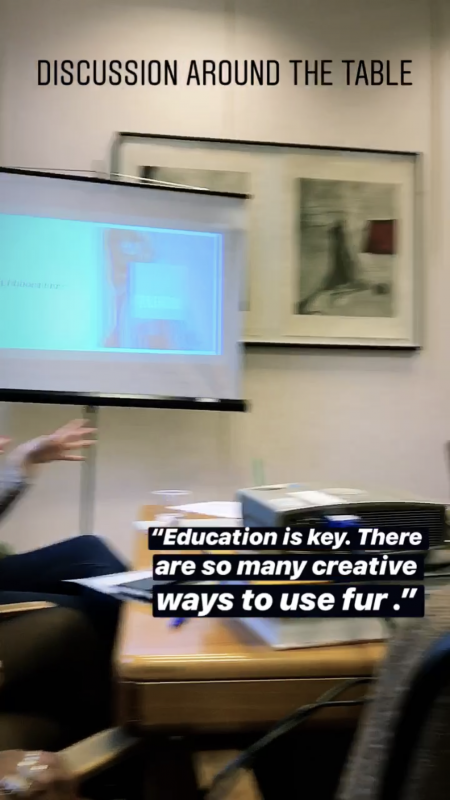
For the first part of the workshop, students began discussing what they thought of natural fur, and why they entered the BFTA competition. Marc, an enthusiastic designer told me he “always felt that I have a strong connection with fur.” Another ardent student, Eliza, explained that this year wasn’t her first year to have entered the competition, and that “last year, I had the privilege to win third prize.” She continued saying that “after winning the third prize, I made a promise to myself; I will be entering this competition until I actually win it.” Another student, Ineta, revealed that she “came across the BFTA competition and decided to give it a go”, whilst never having worked with fur before, the competition had given her “a new perspective, and discovering the BFTA competition was just the perfect timing.” It fortifies the idea that education is fundamental in playing a part of somebody’s refined decision, as plenty of students were open to learning and experimenting, as one student, Mwewa, seamlessly rounded up, “I had such a wonderful time and I learnt so much more about fur than I ever did and I gained so much knowledge that we shouldn’t be afraid to experiment with it.”
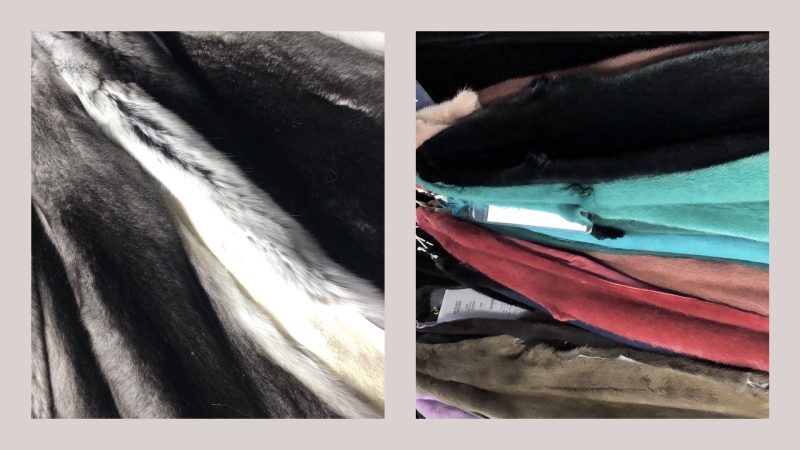
What I was intrigued to know was what the finalists thought of natural fur before applying to the competition, and if their view changed subsequently. From witnessing different types of fur, to realising that fur is a limitless material that can produce endless designs with zero waste, Marc explained that his “point of view in using natural fur in the fashion industry has not changed following the BFTA workshop” as he has “always liked and approved of using natural fur. If anything, the workshop highlighted how much more of a negative impact the use of synthetic fur has on the environment.” Eliza expressed that she “did not have much knowledge about it” and that she was more a consumer rather than a fur designer. She carried on saying that that belief has “ultimately changed when I first entered the competition” as she “truly understands why natural fur is good” and how she will “never use fake fur” due to the detrimental environmental affect it has. Ineta makes an imperative note and tells me that she was a “no fur person” and would use substitutes in her collections because of “all the social media influences and trends”, she continued, “I was sceptical at first but curious, so started researching real information and have absolutely changed my views regarding real fur and submitted my designs for this competition.” Her point is very valid; social media and anti-fur activists have subjugated people’s thoughts and confidence in working with a material that is a clean and sustainable fashion material which is biodegradable, sustainable at every stage of its production and lasts for decades, for an adverse alternative, plastic. She concluded and said that “coming to the workshop and learning even more from industry professionals and seeing things with my own eyes has given me the understanding and a major interest in using and working with real fur.”
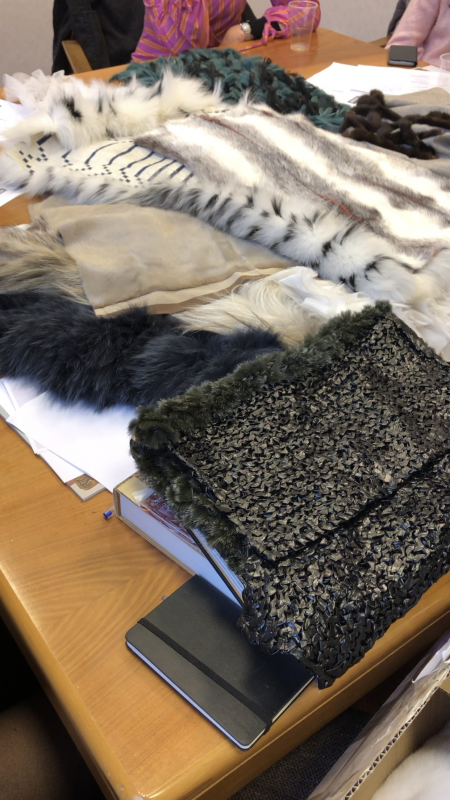
Due to the lack of information from consumers and designers on natural fur, I wanted to know what more could be done to ensure that future fashion students will have the knowledge and capability of working with natural fur. Eliza tells me that the key is “through talking to them.” More of the other students that attended said the same thing, as although universities may be spreading the word, more needs to be done to highlight competitions, and information regarding natural fur in general. However, it’s not enough to purely rely on universities alone. Eliza continues saying that “after winning the third prize, I could hardly stop talking about it. Telling the truth about real fur. Talking about its sustainability and how it is vital for the environment.” This is an effective method for extending the imperative messages that IFF, the BFTA and the whole fur trade promote and believe in. Marc reveals that he intends to “continue educating people to make them understand using fur is not only sustainable, it is the best option to help the planet.” He continues by saying that “the most important thing in my opinion is to educate people so that they understand that there is so much fake news regarding fur… whilst there may be videos of mistreated animals, they do not represent those who work in the fur industry – those people are evil and do not represent the industry. ” Peers listen and understand one another if it comes from someone who they can relate to more than any other way of communication. Additionally, Ineta explained that “social media has so much power over our thoughts and beliefs” and that she was “lucky to decide and learn from the right sources of information.” Ineta supports the idea that some students lack general information about working with fur and that independent research is vital in order to make an educated decision on which side of the argument you stand on. She continues to say, “many students are deprived of information because of tutors’ or other members of staffs’ personal views and this is a steal from the potential of future designers” – this is another very important reason why students who are participating in fur competitions and/or work with fur need to be a leading voice for the fur industry as even in an educational environment, sides are taken.
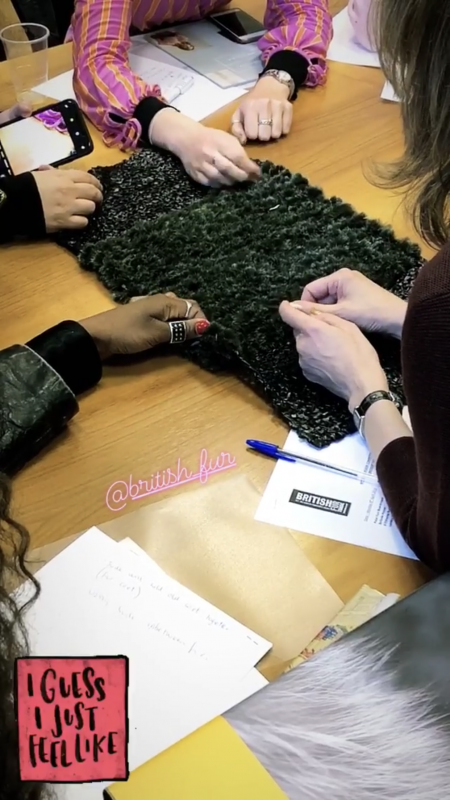
From seeing all the creative ways that fur can be used, I saw the students really inspired and interested which made me think; from a designer’s perspective, what do the students think fur could add to their future designs that other materials simply couldn’t? Ineta told me that using natural fur over plastic fur will “allow me to create intricate surface decorations, create statement looks and because fur can be cut in so many ways and sewn without allowance, it saves material and it can later be remodelled. Possibilities are endless from the design perspective and it is sustainable.” Eliza also adds on to this and tells me that “fur for me is a naturally sustainable product” and that the “world is already drowning in plastic.” Natural fur is a material that, unlike any other material can be re-used over and over again, if taken care of properly, and it “can be reused even if the design is out of fashion, vintage fur is very much valuable and renewable, and therefore for me, it’s sustainable.” – Eliza. Finally, Marc answers, and explains that he is “a designer who always strives for quality… quality fur has a longevity that other fabrics do not have.” He continues, “I want to use quality materials which will last and will look as good as new even years later. This is something fur can do. Fur can add a different dimension, depth and texture to a garment, whereas other materials can be flat. Fur has unique properties that other materials simply don’t.”
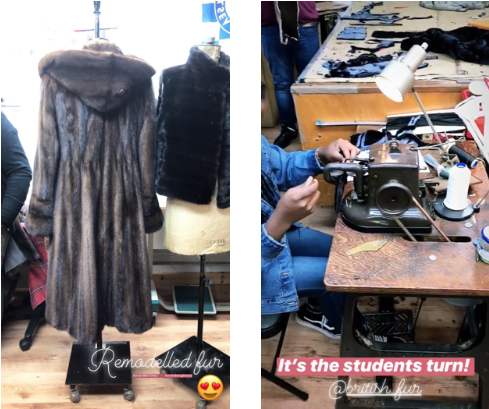
To conclude, the BFTA workshop was a thriving success, where the students thoroughly enjoyed and learnt that natural fur is more than what anti-fur activists say; it delves deeper than fake videos and fake news. It was positive to learn that there are a lot of future fashion design students who are optimistic when learning about fur and actively working with fur – a controversial material that becomes scrutinised by the media due to lack of knowledge. Today’s students and future designers have a key role in shaping what the future of fashion will look like. Therefore, investing in personal and educational research are both key for those students to understanding what materials are available out there to work with so they can in turn then make their own informed choices and decisions based on facts as opposed to propagated media. Embedding sustainability and promoting responsible thinking and sourcing that early on in their careers has never been more important in securing a greener future for us and for them.
We are thankful for the BFTA and other IFF members for their ongoing educational programs around their world and open dialogues with those future designers.
By furfashion
“Everything created by human hands express something – above all the personality of the creator. The same thing is true with a dress. But since so many people are working on it, the real job is to get all the hands that cut, dew, try on and embroider to express all I have felt.”
– Christian Dior, 1954.
The sold-out fashion exhibition the world is talking about, Christian Dior: The Designer of Dreams, is just that – a dream. Housed at London’s iconic Victoria & Albert Museum (V&A), a suspended duck-egg blue ribbon guides the way to one of Dior’s greatest archives where, upon entering its imposing entrance, I was greeted by the early years of Dior’s life and career. Encased in glass are Dior’s first fashion sketches which would ultimately be his gateway into fashion design, combined with facts which chronicled Dior’s Normandy, France, upbringing. All of this softly introduced Dior’s creative genius to eager onlookers. Presented with Dior’s love for gardens, travel, art, architecture and fancy-dress costume design, a series of paintings, photographs and sketches trace Dior’s footsteps to culture and couture capital of the twentieth century – Paris.
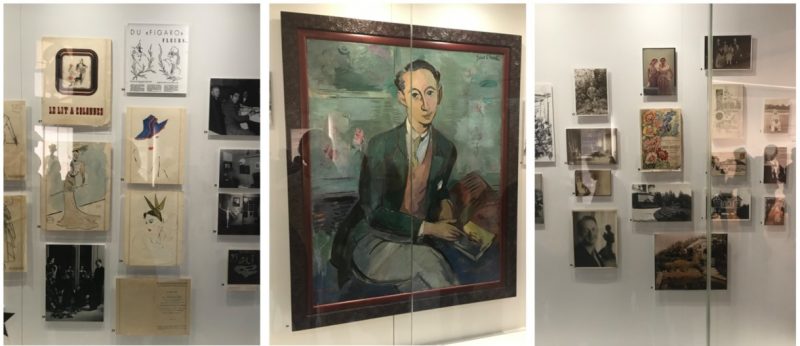
Dior overcame many obstacles to become one of high fashions greatest designers. He fought his parents who pressed him to study Political Science, served his country as a conscript during World War Two, and overcame financial ruin following the 1929 Wall Street Crash. Overcoming all this hardship, Dior unveiled his first haute couture collection on 12 February 1947, where he famously rewrote the fashion rulebook presenting a radical alternative to the masculine boxy female fashions of post-war Paris. Dior’s stand-out silhouettes, which synched the waist of the women who wore them, would become a defining feature of all his collections to come. His soft shoulder, shaped hips and figure hugging pencil skirts celebrated the natural curves of the female form – a look epitomised by Dior’s iconic Bar Suit and Hat look. Carmel Snow, editor in chief of Harper’s Bazaar, announced, “It’s quite a revolution, dear Christian. Your dresses have such a new look!”And thus, Dior and his collection was christened the New Look of high fashion.
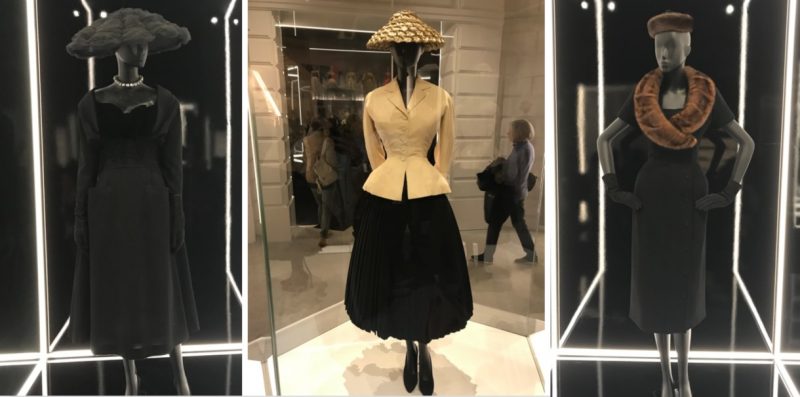
Following the success of Monsieur Dior’s inaugural collection, the world eagerly awaited each up-coming collection. Dior designed 22 collections throughout his career, many made up of 150-plus looks and each one paying homage to female curves through structure and proportions. Dior’s innovative designs ensured new and returning custom and, ultimately, the continued success of the design house. Dior confessed 10-years after his first show, in 1957, “I think of my work as ephemeral architecture, dedicated to the beauty of the female body”– a statement which highlights his passion for architecture and fashion, and the mutually-informing symbiotic relationship of both.
Causing quite the sensation when it was first released was Dior’s H line. Worn by Hollywood starlet Jane Russel, famous for her curvy figure, in part to shun critics who accused the design of suppressing the female body when previous collections had celebrated it, the design features a material Christian Dior himself, and the house of Dior today, love: Fur. The fitted black dress with button detailing and warm brown mink collar, with matching hat trim, suited the starlet beautifully and proved its allure on all body types.
Dior infused natural fur in his ready-to-wear and haute couture collections throughout his career. And since his untimely death, in October 1957, all the creative directors who took the helm at Dior continued the house’s affinition and use of the material. Christian Dior’s golden age of fur came when Frederick Castet was appointed the head of Dior’s fur division. Castet became Dior’s master furrier and, along with the Fendi sisters among others, brought innovative fur styling into mainstream fashion by 1968. Known for his bold treatment of furs, Castet trimmed, plucked, dyed and cut any and all types of pelts in an era where Dior furs were growing in popularity. Fast forward nearly twenty years, to the 1980’s, a time of ostentatious luxury, glamour, powerful women, and extravagant styles, a triumphal era for Dior Fourrure, Dior was teaming with customers flooding stores to buy furs with costly price tags. Dior’s furs had become fashions hottest commodity, much which can be attributed to Frederick Castet. Today, the house of Dior stands confident and strong in their resolve to use sustainable and natural materials, like fur, leather, silk and wool, in their womenswear and menswear collections with artistic directors one after the other parading natural fabrics on the catwalk, keeping Christian Dior’s love of the magnificent natural materials alive.
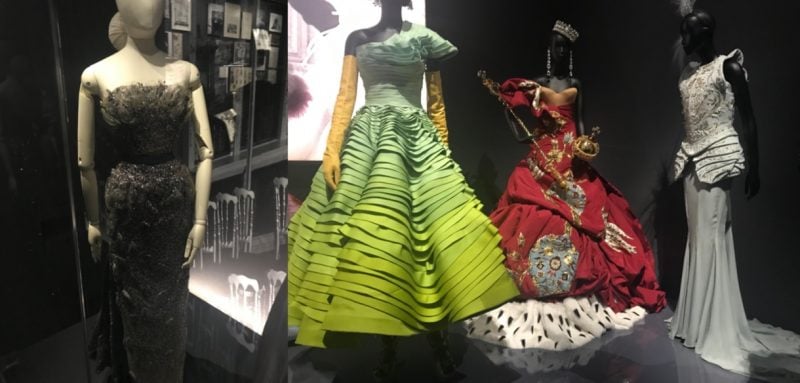
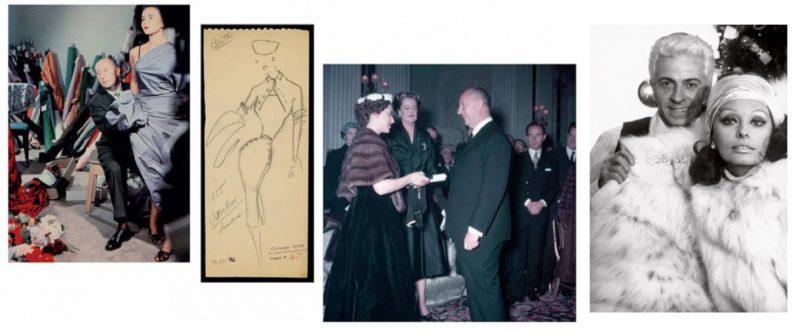
As I navigate the rooms of this exhibition, each one beautifully reflecting the era in which the clothes they display were created, the inspirations and vision of each period is too kept alive. This exhibition pays homage to and celebrates the many countries Christian Dior travelled to, expressing the brands DNA whilst never crossing the line between cultural appropriation and appreciation – something many brands fail to do with such poise. An Egyptian inspired era of Dior’s history, showcasing John Galliano’s gold and turquoise sphinx inspired gowns, seamlessly transitions into an amber glow with designs of bold red, the colour of good fortune in China, another source of inspiration for Dior. The creations of Asian inspired artisan Raf Simon’s are nestled side-by-side Jardin Japonais 1953 intricate Japanese cherry blossom inspired ball gowns. Mesmerised by their intricate beauty, but not for long, as they are cushioned by captivating Indian inspired saris designed by Marc Bohan. All of this makes for a colourful display of culture.
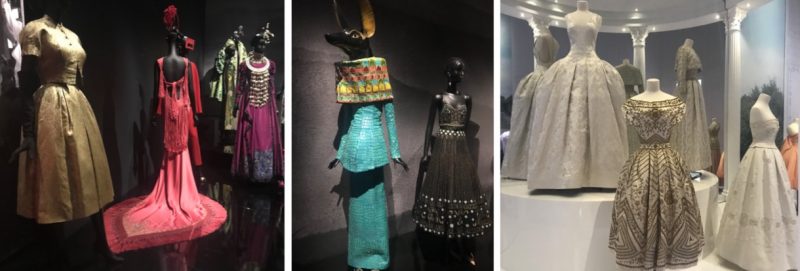
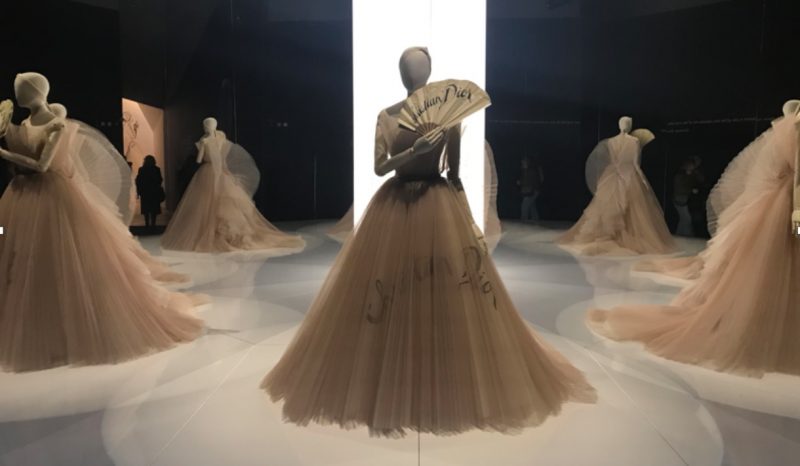
Dior was inspired by the many countries and cities he visited, most notably Britain and its capital city, London. It seems ironic that during a time where Britain wishes to sever ties with the European Union, of which France is a central pillar, an iconic French designer would be declaring his love for Britain in central London. Nonetheless, politics aside, a cross-channel love-affair between Dior and Britain it was, and one which is still blossoming today.
One particular cross-channel friendship which stood the test of time belongs to long-time mutual admirers Christian Dior and Princess Margaret, the younger glamorous sister of the current monarch, Queen Elizabeth. Following his first fashion show in London, Dior began supporting British charities through his shows, often working with British fabric designers and manufacturers. It was during this time he shared a friendship full of fashion with the young princess. In fact, the mutual adoration between Dior and the British princess led Dior’s to create one of his most famous looks: Princess Margaret’s 21stbirthday dress. This buttoned bodice and full golden embroidered dress simultaneously represented Dior’s New Look – highlighting the petit princess’s small waist – whilst at the same time reflecting the conventions of tradition through the dress’s royal grandeur. This dress not only illuminates how Dior embraced Britain, and the British adopted the Frenchman in return, but, it also demonstrates Dior’s talent for infusing history with modernity, and art with architecture.
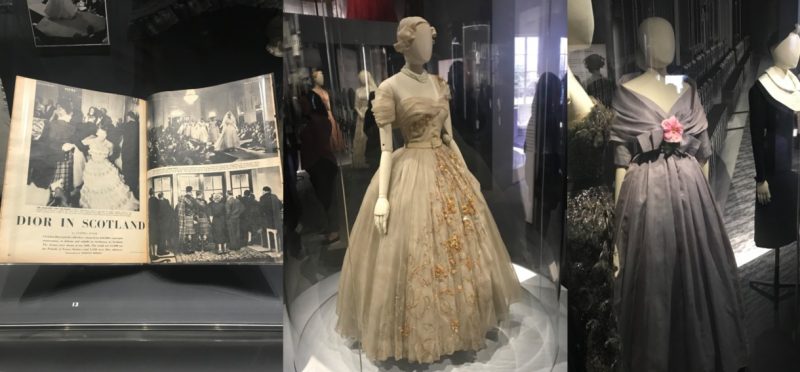
“The relationship between Monsieur Dior and British culture is fascinating,” the current creative director of Dior, Maria Grazia Chiuri, told Vogue during a preview.“He came here because he wanted to be free – it’s the same story of many. Britain is a place that is strongly about freedom and this comes across in its fashion. I’m lucky to have this important legacy to move the brand forward.”
Christian Dior: Designer of Dreamsis the most creatively and culturally progressive exhibition of the twenty-first century. Demonstrating the difference between cultural appropriation and appreciation, Dior’s exhibition is bursting with inclusivity. It’s a celebration of glamour and architecture and a signifier of innovative art and design. Christian Dior will forever be known for creating a New Look which changed fashion’s history and future forever. He is Christian Dior, the Designer of Dreams and architect of aspiration.
By furfashion
March 22, 2019
Growing up on a farm, Brooke quickly became accustom to the production processes in animal industries. From a young age, Brooke appreciated the natural resources the animal industries have given mankind for millennia, and it is for this reason she designs and creates with respect when using fur and other natural fabrics. In fact, Brooke confesses…
the more I researched fur and began to work with furriers on the production of garments, the more I understood the inner workings of the industry – especially the animal welfare on farms – which is something I wholehearted support.
(me too!)
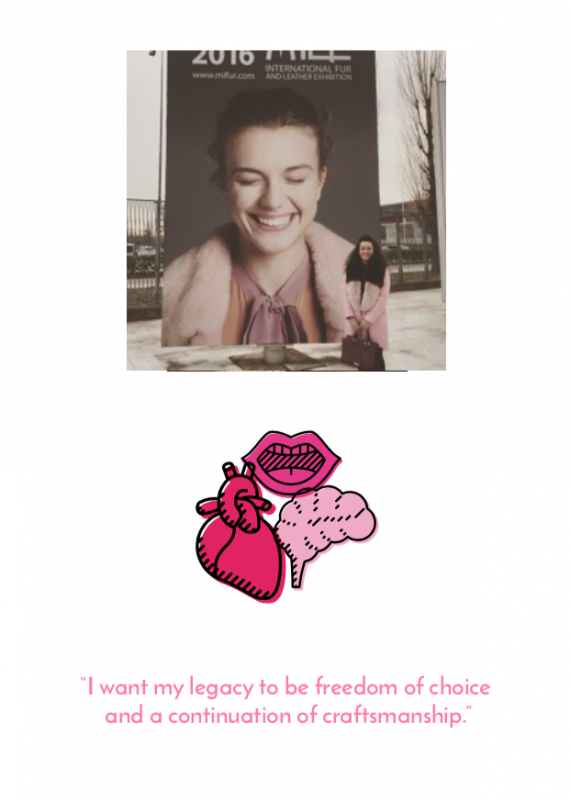
So, the next question would of course be: Where do you source your fur from, Brooke?
Primarily I source my fur from fur merchants which I know have the highest levels of animal welfare – independently regulated of course. Today, a lot of the new furs I source I get from fur exhibitions like MiFur in Milan through which I have met a number of small family businesses who have become my suppliers. This is one of the reasons I love attending exhibitions, and enjoy sourcing fur from MiFur, because I feel it is important to source from the very best and to keep up to date with new techniques and trends. Mifur offers the chance to view exhibitors from all over the world in all different forms regarding the Fur industry from pelts to machinery and it is key to little designers like myself not only for sourcing but also to make new friends and connections.
I can’t help but feel from talking to Brooke that much of her passion for working with fur comes from the family-orientated nature of the fur industry. From sourcing fur to production of garments, Brooke is brimming with heartfelt stories which fuels her drive to work in this integrated community. I particularly enjoyed on account, I will let Brooke tell you all in her own words.
One of my first jobs when I started doing repairs was for a family close to me who had unfortunately lost their grandmother. In possession of their grandmother’s old leopard print beaver, which has started to wilt, as all natural products do, they wanted me to remodel the coat into something they could remember their grandmother by. So, I made this lady’s daughter, grand-daughter and great-grand-daughter, three fur bags. Something practical and sentimental which made for an emotional reception as I’m sure you can imagine. They were so grateful that they could cherish their family members memory, and have something they could use. This duality of fur is something you can’t get with any other material.
(We can all find parallels between Brooke’s account and our own truths, what a beautiful story, thank you Brooke for sharing.)
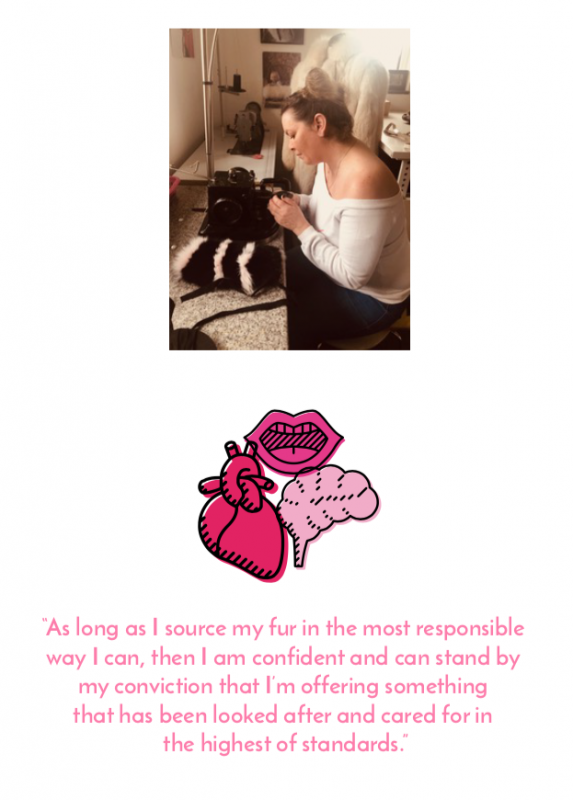
This highlights another important factor that I stand for as a fashion designer and manufacture, expending the life cycle of clothes simultaneously rejecting fast fashion and throw away culture. Additionally, this story helps debunk the myth that fur fashion is a luxury item, it doesn’t have to be! My creations, whether bespoke new pieces or remodelled creations are all affordable tailor-made fashion and accessories to the highest degree.
Having made such an impact on so many lives through your creations. It begs the questions: what do you want your design legacy to be? I, and my readers, would love to know.
I want my legacy to be freedom of choice and a continuation of craftsmanship. While fur is considered a luxury fabric, as I have already said, it is not because of its price. Fur is a luxury item because of its versatility and beauty, because of the craftsmanship that goes into it, this is rare in today’s fashion industry. And this is something I won’t ever take away from fur, it is a material everyone can enjoy.
Brooke’s passion for fur has reignited my own adoration of the fabric. It feels like Brooke has grown up in a fur trade legacy because she is so knowledgeable on the complex debates that surround the industry. So, you can imagine the Fur Guru’s surprise when Brooke confessed that she is the first person in her family and inner circle of friends to work with fur. Has this been an easy road Brooke?
I remember a time when one of my friends blurted out “I can’t believe you work with real fur”, and I had to kindly remind her, “but you’re standing in a pair of Ugg boots telling me that, do you know what they are?” And that’s the issue with today’s consumers, a lot of people don’t know what they have and where it comes from. This is something I promote and am transparent about.
I am aware of this kind of conflict that surrounded fur in the 80’s, while I was not working with fur back then, it appears the same challenges have resurfaced. It is my job as a fur designer to use my knowledge and position to educate those around me.
When I first started working with fur I felt proud. And since then, I have had to educate my friends and family on the inner workings of the fur trade. Today, my mum and sister are so supportive, they often accompany me to fairs. They, like me, love it!
Brooke explained that her sister, also a young creative, is a florist who has expanded her store to stock fur homeware goods like cushions that Brooke designs and produces. They are the first generation of a fur family legacy and the fur guru is proud of these sisters for their creativity and innovation.
As always Brooke, I end my Here Come the Girls features with a quote which you remember at tough times or career goals, is there a quote you can share with us?
“Anything is possible, keep dreaming, believe and achieve”
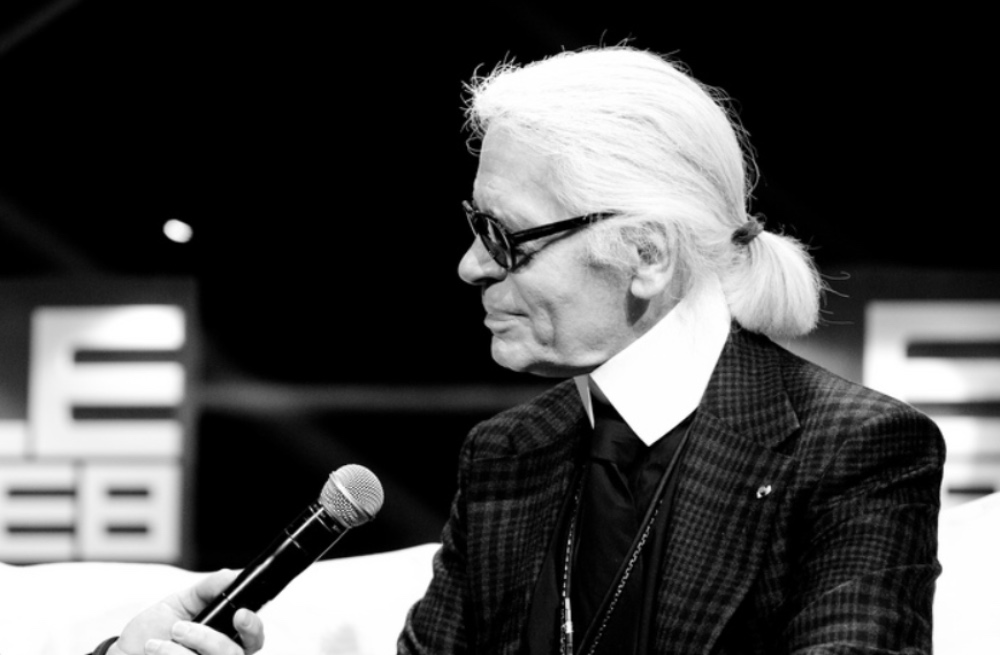
By furfashion
February 20, 2019
Yesterday, not only the fashion community, the entire world said goodbye to one of the greatest living cultural and creative powerhouses of the twentieth century: Karl Lagerfeld. Born in Hamburg, German, Lagerfeld was, foremost, the creative mind behind Fendi since the 1960s and Chanel since the 1980s, known for his bold and unapologetic designs and constant reinvention of the wheel – he was crowned by Vogue as the “unparalleled interpreter of the mood of the moment.”
Starting his career with Yves Saint Laurent, before moving into an apprentice role with Pierre Balmain, Lagerfeld went on to create his own label as well as designing for Chloe and Fendi where he oversaw the companies infamous and longevous fur line. Lagerfeld was a fur advocate and admirer, using his appreciation for past and in-the-moment styles to create signature collections which is photographed up until his passing.
Photography was another passion of Lagerfeld’s, by the time he enters the 80’s, he was a fashion star with the press who often chronicled his life along with friend Andy Warhol. The eye behind the camera lens of many of his campaigns, Lagerfeld revived the nearly extinct fashion house Chanel at the start of the 90’s introducing the infamous ready-to-wear collection which lives on in fashion history as one of the most iconic fashion moments – a decade the world will never forget.
Tributes poured in from supermodels of the past and present, designers whom Lagerfeld inspired and nurtured, and stars who revelled in his kind-hearted nature and wit. Lagerfeld’s influence in fashion, photography, film and culture is a footprint too big to fill, he will never be replaced. In a sea of solemn tributes that flood the media, none can sum up his unrivalled contribution to the way we, and in particular women, view fashion and themselves. The fur industry today mourns a great friend whom saw in natural fur the magical wonder it is and crafted masterpieces inspiring generations to come to never be afraid of criticism and stand-up for your beliefs.
Karl Lagerfeld’s work and legacy will live on forever. He was and will always be a visionary and icon.
View simple steps on how to thread a fur sewing machine here:
Introducing Tony Glyn, Glyns Collections
How did you start out as a furrier?
My father started out as a furrier in 1921 at the age of 17. When I was a young boy at school I spent every minute I could during the school holidays and lunch times in my fathers factory as my school was in walking distance. That was my earliest experience of the fur trade. Immediately after leaving school I started training to be a furrier, also at the age of 17. I trained in London with a chamber master who worked in Bond Street. There I made my first mink coat (a sapphire 3/4), an exciting and proud moment which I will never forget. That was approx 60 years ago. Time does fly when you enjoy what you do… 🙂
What do you love about working with fur?
We make new and also remodel and alter furs. I find working with fur very pleasing and rewarding as no two jobs are the same. Each one requires a different approach and it is the challenge that I love. When making new garments I love to marry up the different types of fur, to give it a unique look resulting in another happy customer.
What does sustainability mean to you?
We have many customers who have acquired coats from their parents and grandparents and if in good condition, they can all be brought up to date with remodelling, instead of being thrown away and replaced with faux fur. That is the definition of sustainability in my eyes and there is also the added emotional aspect of making it possible for people to wear their family heirloom.
What do you see as the challenges?
The biggest challenge is to keep our standards high so that our customers, old and new, can enjoy green and ethical products that are self sustaining, natural and timeless. I love the fur trade. It is exiting, satisfying and rewarding.
Glyns Collections can be found at: 2nd Floor, Conavon Court, 12 Blackfriars Street, Manchester M3 5BQ Tel : 0161 834 7581
Instagram @glynscollections
Further information: Read a blog post by Gabrielle, who has recently been working with Glyns Collections.